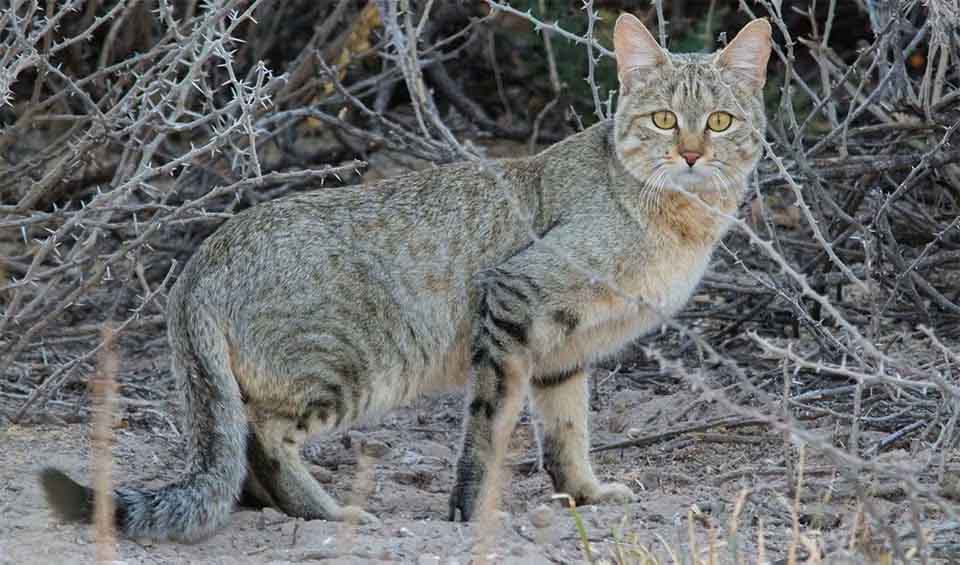A fascinating and elusive feline native to a wide range of habitats across Africa, as well as parts of the Middle East and Central Asia. Known for its striking resemblance to domestic cats, the African wildcat is believed to be the ancestor of all modern domestic cats. This small predator plays a crucial role in its ecosystem, maintaining the balance of small mammal populations and exhibiting a range of behaviors that highlight its adaptability and survival skills.
Their fur varies in color from grayish-brown to tawny, with darker stripes on their legs, tail, and sometimes their back. These markings help provide camouflage in their natural habitats, which include savannas, grasslands, deserts, and scrublands. The wildcat’s eyes are typically a pale green or amber, and they have distinctive pointed ears with reddish-brown backs and a white spot near the base.
One of the most notable aspects of the African wildcat is its solitary and nocturnal nature. These cats are highly territorial and prefer to hunt alone, primarily during the night when their prey is most active. Their diet mainly consists of small mammals, such as rodents and hares, but they also eat birds, reptiles, insects, and occasionally amphibians. African wildcats are skilled hunters, using their keen senses of sight, hearing, and smell to locate prey. They employ a stealthy approach, stalking their prey silently before pouncing with precision and speed.
African wildcats are also known for their adaptability and ability to thrive in diverse environments. They can survive in arid regions by obtaining moisture from their prey and are also capable of living in more temperate zones with abundant water sources. This adaptability has enabled them to occupy a wide range of ecological niches across their vast range.
Distribution
 Afghanistan
Afghanistan Algeria
Algeria Angola
Angola Armenia
Armenia Azerbaijan
Azerbaijan Benin
Benin Botswana
Botswana Burkina Faso
Burkina Faso Burundi
Burundi Cameroon
Cameroon Central Af. Rep.
Central Af. Rep. Chad
Chad China
China Côte D’ivoire
Côte D’ivoire DR Congo (Kinshasa)
DR Congo (Kinshasa) Djibouti
Djibouti Egypt
Egypt Eritrea
Eritrea Eswatini
Eswatini Ethiopia
Ethiopia France
France Gambia
Gambia Georgia
Georgia Ghana
Ghana Greece
Greece Guinea-Bissau
Guinea-Bissau Guinea
Guinea India
India Iran
Iran Iraq
Iraq Israel
Israel Italy
Italy Jordan
Jordan Kazakhstan
Kazakhstan Kenya
Kenya Kuwait
Kuwait Kyrgyzstan
Kyrgyzstan Lebanon
Lebanon Lesotho
Lesotho Libya
Libya Malawi
Malawi Mali
Mali Mauritania
Mauritania Mongolia
Mongolia Morocco
Morocco Mozambique
Mozambique Namibia
Namibia Nepal
Nepal Niger
Niger Nigeria
Nigeria Oman
Oman Pakistan
Pakistan Russia
Russia Rwanda
Rwanda Saudi Arabia
Saudi Arabia Senegal
Senegal Sierra Leone
Sierra Leone Somalia
Somalia South Africa
South Africa South Sudan
South Sudan Spain
Spain Sudan
Sudan Syria
Syria Tajikistan
Tajikistan Tanzania
Tanzania Togo
Togo Tunisia
Tunisia Turkmenistan
Turkmenistan Turkey
Turkey UAE
UAE Uganda
Uganda Uzbekistan
Uzbekistan Yemen
Yemen Zambia
Zambia Zimbabwe
ZimbabweAnything we've missed?
Help us improve this page by suggesting edits. Glory never dies!
Suggest an editGet to know me
Terrestrial / Aquatic
Altricial / Precocial
Polygamous / Monogamous
Dimorphic (size) / Monomorphic
Active: Diurnal / Nocturnal
Social behavior: Solitary / Pack / Herd
Diet: Carnivore / Herbivore / Omnivore / Piscivorous / Insectivore
Migratory: Yes / No
Domesticated: Yes / No
Dangerous: Yes / No




